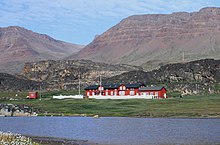Arctic station of the University of Copenhagen
Coordinates: 69 ° 15 ′ N , 53 ° 31 ′ W
The Arctic Station of the University of Copenhagen ( Danish Arktisk Station , Greenlandic Angakkussarfik ) is a scientific institution on the Disko Island belonging to Greenland .
location
The station is located in a nature reserve near the south coast of Disko Island, a good 300 meters northeast of the outskirts of Qeqertarsuaq . It is located at a height of 20 m above sea level on a small lagoon , which is separated from the open sea of Disko Bay by a black sand beach , where the Qeqertarsuaq heliport is located. There are always huge aground icebergs off the coast . Behind the station a cliff rises steeply 600 m. The Røde Elv (“Red River”) flows about 850 m to the east and is fed by the runoff from several glaciers .
history
The Danish botanist Morten Pedersen Porsild founded “Den Danske Arktiske Station” in 1906. His idea was also supported by important polar researchers such as Knud Rasmussen , Fridtjof Nansen and Ludvig Mylius-Erichsen . The Danish government covered the costs of 35,000 Danish kroner for the construction of the station and 10,000 kroner annually for its operation. In 1920 the main building was extended to the east and a library and laboratories were added. Porsild was the scientific station manager for almost 40 years. In 1946 he returned to Denmark, and Paul Gelting (1905–1964) took over the management of the station.
In 1947/48 a new house was built for the scientific director. In 1953, the University of Copenhagen took over what is now called "Arktisk Station". In 1955/56 another building for the workshop and garage was added. Ten years later, the library was moved to a newly built outbuilding. Until 1978, the facility could only be used by biologists. After that, her scientific orientation expanded so that she also opened up to other natural scientists such as geologists and geographers. In 1979/80 the main building was completely renovated for about 5 million DKK, in 1983 also the home of the scientific director and in 1985 the workshop. The Arctic station is now the northernmost facility of the University of Copenhagen and one of the few research stations north of the Arctic Circle that is manned all year round.
description
organization
The Arctic station is overseen by a five-person body set up by the Faculty of Science at the University of Copenhagen . It consists of one representative each from the Botanical, Zoological, Geological and Geographic Institutes as well as a member named directly by the faculty. There are three permanent employees on site: the scientific director, the manager and the master of the research vessel Porsild .
building
In the main building of the Arctic station with an area of 660 m² there is a lecture room, a lounge, a canteen and a kitchen. Up to 26 guests can be accommodated in the bedrooms. In the western part of the house are the private rooms of the manager and his family (104 m²). The laboratory and library building has an area of 225 m² on two floors. The library contains around 6,000 books and an extensive collection of magazines with a polar theme. The scientific director has private rooms of 120 m² plus a cellar available. There is a workshop with a garage (70 m²) and a storage shed (20 m²).
climate
The arctic marine climate at the station is influenced by Baffin Bay . It is characterized by a relatively high amount of precipitation and large temperature fluctuations. The mean annual temperature is -3.2 ° C, the mean temperature in January -11.6 ° C and in July 7.6 ° C. Every year, an average of 436 mm of precipitation falls. In winter, the wind preferably comes from the east, influenced by cold katabatic winds from the Greenland ice sheet , in summer, however, mostly from the west, where it brings mild maritime air masses.
research
A long-term monitoring program called DiskoBasis was started in 2013. DiskoBasis expands and supplements the monitoring of the local ecosystem that the station has carried out for a century and is financed by the Danish Ministry of Energy.
The primary goal of the program is to collect long-term data series on the geophysical and biological conditions of the terrestrial and maritime environment of the station. It thus complements the existing monitoring programs in Nuuk and at the Zackenberg research station in Northeast Greenland . DiskoBasis collects data on meteorology , carbon dioxide exchange between land and atmosphere , soils and vegetation , hydrology and sediment transport in Røde Elv, limnology and the properties of seawater .
Individual evidence
- ↑ a b Bent Hasholt: Arktisk Station . In: Andrew Jon Hund (Ed.): Antarctica and the Arctic Circle: A Geographic Encyclopedia of the Earth's Polar Regions . tape 1 . ABC-CLIO, Santa Barbara 2014, ISBN 978-1-61069-392-9 , pp. 111–112 ( limited preview in Google Book search).
Web links
- Arctic Station on the homepage of the INTERACT project
- Homepage of the Arctic Station


